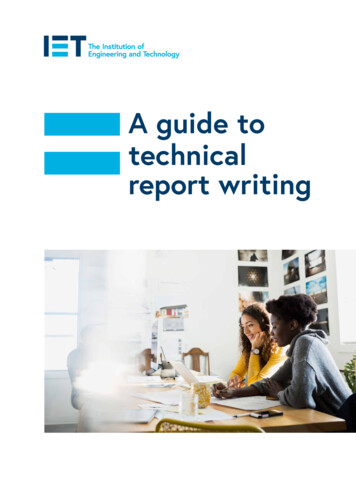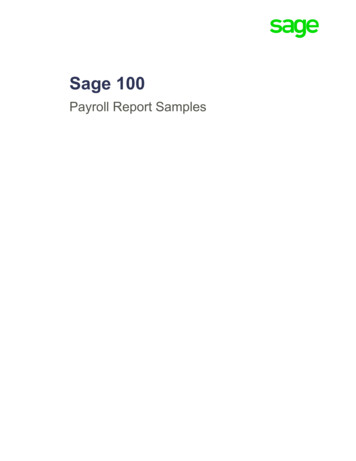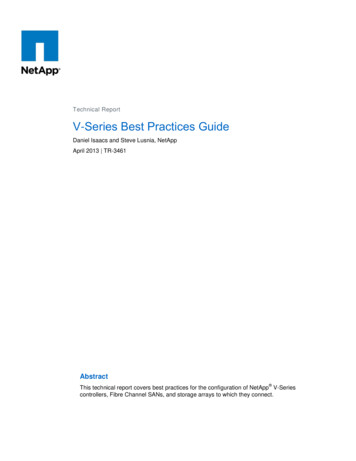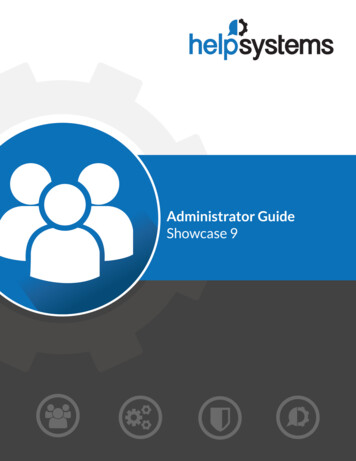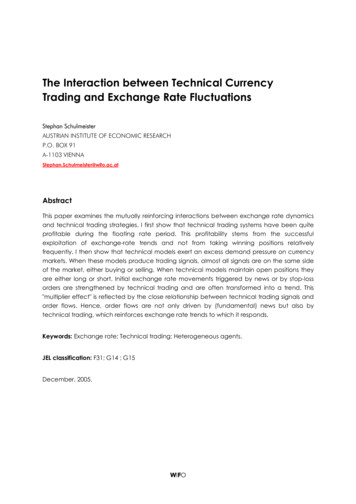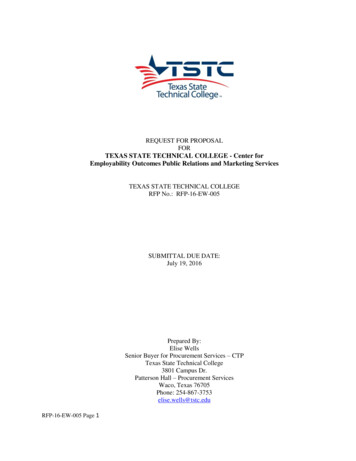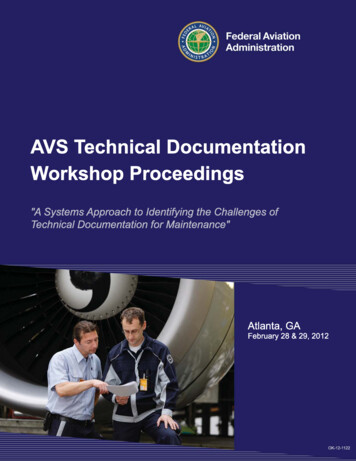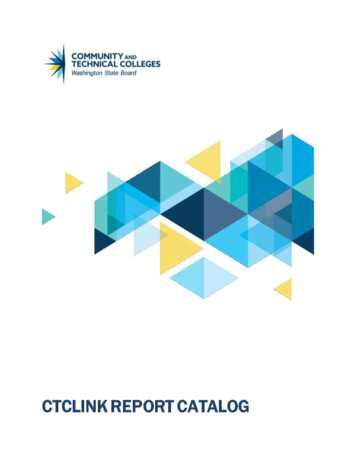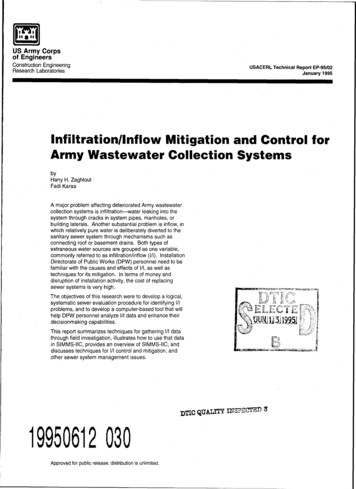
Transcription
US Army Corpsof EngineersConstruction EngineeringUSACERL Technical Report EP-95/02Research LaboratoriesJanuary 1995Infiltration/Inflow Mitigation and Control forArmy Wastewater Collection SystemsbyHany H. ZaghloulFadi KaraaA major problem affecting deteriorated Army wastewatercollection systems is infiltration-water leaking into thesystem through cracks in system pipes, manholes, orbuilding laterals. Another substantial problem is inflow, inwhich relatively pure water is deliberately diverted to thesanitary sewer system through mechanisms such asconnecting roof or basement drains. Both types ofextraneous water sources are grouped as one variable,commonly referred to as infiltration/inflow (I1/). InstallationDirectorate of Public Works (DPW) personnel need to befamiliar with the causes and effects of I/I, as well astechniques for its mitigation. Interms of money anddisruption of installation activity, the cost of replacingsewer systems is very high.The objectives of this research were to develop a logical,systematic sewer evaluation procedure for identifying I/1help DPW personnel analyze I/I data and enhance theirdecisionmaking capabilities.A,,-L,JI.J)iRIThis report summarizes techniques for gathering I/I datathrough field investigation, illustrates how to use that datain SIMMS-IIC, provides an overview of SIMMS-IIC, andLdiscusses techniques for I1/control and mitigation, andother sewer system management issues.rBn' CVDTIC QUAIMINP19950612 030Approved for public release; distribution is unlimited.3
The contents of this report are not to be used for advertising, publication,or promotional purposes. Citation of trade names does not constitute anofficial endorsement or approval of the use of such commercial products.The findings of this report are not to be construed as an officialDepartment of the Army position, unless so designated by other authorizeddocuments.DESTROY THIS REPORT WHEN IT IS NO LONGER NEEDEDDO NOT RETURN IT TO THE ORIGINATOR
USER EVALUATION OF REPORTREFERENCE: USACERL Technical Report EP-95/02, Infiltration/Inflow Mitigation and ControlforArmy Wastewater Collection SystemsPlease take a few minutes to answer the questions below, tear out this sheet, and return it to USACERL.As user of this report, your customer comments will provide USACERL with information essential forimproving future reports.1. Does this report satisfy a need? (Comment on purpose, related project, or other area of interest forwhich report will be used.)2. How, specifically, is the report being used?management procedure, source of ideas, etc.)(Information source, design data or procedure,3. Has the information in this report led to any quantitative savings as far as manhours/contract dollarssaved, operating costs avoided, efficiencies achieved, etc.? If so, please elaborate.4.What is your evaluation of this report in the following areas?a. Presentation:b. Completeness:c. Easy to Understand:d. Easy to Implement:e. Adequate Reference Material:f. Relates to Area of Interest:g. Did the report meet your expectations?h. Does the report raise unanswered questions?
i. General Comments. (Indicate what you think should be changed to make this report and futurereports of this type more responsive to your needs, more usable, improve readability, etc.)5. If you would like to be contacted by the personnel who prepared this report to raise specific questionsor discuss the topic, please fill in the following information.Name:Telephone Number:Organization Address:6. Please mail the completed form to:Department of the ArmyCONSTRUCTION ENGINEERING RESEARCH LABORATORIESATTN: CECER-IMTP.O. Box 9005Champaign, IL 61826-9005
REPORT DOCUMENTATION PAGEFormNo.ApprovedR DOMB0704-0188Public reporting burden for this collection of information is estimated to average 1 hour per response, including the time for reviewing instructions, searching existing data sources,gathering and maintaining the data needed, and completing and reviewing the collection of information. Send comments regarding this burden estimate or any other aspect of thiscollection of information, including suggestions for reducing this burden, to Washington Headquarters Services, Directorate for information Operations and Reports, 1215 JeffersonDavis Highway, Suite 1204, Arlington, VA 22202-4302, and to the Office of Management and Budget, Paperwork Reduction Project (0704-0188), Washington, DC 20503.1. AGENCY USE ONLY (Leave Blank)2. REPORT DATEJanuary 19953. REPORT TYPE AND DATES COVEREDFinal4. TITLE AND SUBTITLE5. FUNDING NUMBERSInfiltration/Inflow Mitigation and Control for Army Wastewater CollectionSystems4A162720A896NN-TN26. AUTHOR(S)Hany H. Zaghloul and Fadi Karaa7. PERFORMING ORGANIZATION NAME(S) AND ADDRESS(ES)U.S. Army Construction Engineering Research Laboratories (USACERL)P.O. Box 9005Champaign, IL 61826-90059. SPONSORING/MONITORING AGENCY NAME(S) AND ADDRESS(ES)B. PERFORMING ORGANIZATIONREPORT NUMBERTR EP-95/0210. SPONSORING/MONITORINGAGENCY REPORT NUMBERU.S. Army Center for Public Works (USACPW)ATTN: CECPW-ES7701 Telegraph RoadAlexandria, VA 22310-386311. SUPPLEMENTARY NOTESCopies are available from the National Technical Information Service, 5285 Port Royal Road, Springfield, VA22161.12a. DISTRIBUTION/AVAILABILITY STATEMENT12b. DISTRIBUTION CODEApproved for public release; distribution is unlimited.13. ABSTRACT (Maximum 200 words)A major problem affecting deteriorated Army wastewater collection systems is infiltration-water leaking intothe system through cracks in system pipes, manholes, or building laterals. Another substantial problem is inflow,in which relatively pure water is deliberately diverted to the sanitary sewer system through mechanisms such asconnecting roof or basement drains. Both types of extraneous water sources are grouped as one variable,commonly referred to as infiltration/inflow (I/I). Installation Directorate of Public Works (DPW) personnel needto be familiar with the causes and effects of I/I, as well as techniques for its mitigation. In terms of money anddisruption of installation activity, the cost of replacing sewer systems is very high.The objectives of this research were to develop a logical, systematic sewer evaluation procedure for identifyingI/I problems, and to develop a computer-based tool that will help DPW personnel analyze I/I data and enhancetheir decisionmaking capabilities.This report summarizes techniques for gathering I/1 data through field investigation, illustrates how to use thatdata in SIMMS-IIC, provides an overview of SIMMS-IIC, and discusses techniques for I/I control andmitigation, and other sewer system management issues.14. SUBJECT TERMSwastewater collection systeminfiltration/inflow (I/I)sewer rehabilitation17. SECURITY CLASSIFICATIONOF REPORTUnclassifiedNSN 7540-01-280-550015. NUMBER OF PAGESSIMMS-IIC18. SECURITY CLASSIFICATIONOF THIS PAGEUnclassified7619. SECURITY CLASSIFICATIONOF ABSTRACTUnclassified20. LIMITATION OF ABSTRACTSARStandard Form 298 (Rev. 2-89)Prescribed by ANSI Std 239-18298-102
FOREWORDThis research was performed for the U.S. Army Center for Public Works (USACPW) underProject 4A162720A896, "Environmental Quality Technology"; Work Unit NN-TN2, "Technology toRenovate Army Potable Water Infrastructure." The technical monitor was Malcolm McLeod, CECPW-ES.The work was conducted by the Environmental Engineering Division (EP) of the EnvironmentalSustainment Laboratory (EL), U.S. Army Construction Engineering Research Laboratories (USACERL).Fadi A. Karaa is Principal, Planning and Development Applications (PDA), Belmont, MA. Thearchitecture of the software tool developed in this research is based on the PDA computer programSIMMSTM. Dr. Edgar D. Smith is Acting Chief, CECER-EP, and William D. Goran is Chief, CECER-EL.The USACERL technical editor was Gordon L. Cohen, Information Management Office.LTC David J. Rehbein is Commander and Acting Director of USACERL.O'Connor is Technical Director.2Dr. Micheal J.
CONTENTSPageSF 298FOREWORDLIST OF FIGURES AND TABLES1251INTRODUCTION . .BackgroundObjectivesApproachScopeSIMMS-IIC System RequirementsMode of Technology Transfer72DATA ACQUISITION TECHNIQUES FOR SEWER SYSTEM EVALUATION.10DefinitionsData Acquisition Plan for I/I AnalysisFlow Isolation Gaging ProgramRehabilitation Decisionmaking3OVERVIEW: SEWER INVENTORY AND MAINTENANCE MANAGEMENTSYSTEM FOR INFILTRATION AND INFLOW CONTROL (SIMMS-IIC) .Program OverviewThe Main SelectionsTwo Examples194FUNCTIONAL SPECIFICATIONS FOR SIMMS-IIC .Facilities Inventory ModuleData Acquisition Plan ModuleCondition Evaluation ModuleRehabilitation Task Analysis ModuleRehabilitation Planning Module305SIMMS-IIC INFORMATION STRUCTURE .Inventory LogSubsystem-Level Flow MeasurementCondition EvaluationRehabilitation TechniquesRehabilitation ProgramSystem TablesDefect Categorization and Condition AssessmentRehabilitation Cost-Effectiveness AnalysisRehabilitation Task CostingLine and Spot Repairs356SUMMARY .52METRIC CONVERSION FACTORS52REFERENCES533
CONTENTS (Cont'd)PageAPPENDIX A: Design and Construction Standards for New SewersAPPENDIX B: Terms Used in SIMMS-IICAPPENDIX C: SIMMS-IIC System Requirements, Installation, andConfigurationAPPENDIX D: Sample Forms for Sewer System ComponentEvaluationAPPENDIX E: Program Printout ExamplesDISTRIBUTION45457596165
FIGURESNumberPageIFlowchart for SIMMS-IIC Program Input202Flowchart for SIMMS-IIC Program Output213Main System Menu Tree224Flow Isolation Menu Tree225Queries and Reports Menu Tree236System Utilities Menu Tree237Two Examples of System Tables40TABLESISuitability of Rehabilitation Tasks to Sewer System Components262Manhole Infiltration System273Line Segment Infiltration System284Service Lateral Infiltration System295Costs of Pipeline Removal and Replacement446Grouting Preparation Costs457Remote Grouting Costs468Manned Entry Chemical Grouting Costs469Cement Mortar Lining Costs4710Reinforced Shotcrete Lining Costs4811Pipe Insertion Unit Costs4912Pipe Insertion Unit Costs Using High-Density Extruded Polyethylene Pipe Liner4913Pipe Insertion Unit Costs for Resin Impregnated Fabric Inversion Lining5014Pipe Insertion Unit Costs for Reinforced Thermosetting Resin Pipes515
INFILTRATION/INFLOW MITIGATION AND CONTROL FORARMY WASTEWATER COLLECTION SYSTEMS1INTRODUCTIONBackgroundWastewater collection systems on Army installations require periodic maintenance and repair(M&R), and occasionally must be upgraded. A well designed, well operated wastewater collection systemcan effectively handle the changing wastewater flow volumes, serve new facilities, and mitigate the effectsof wear and tear on the system. Sewers deteriorate due to internal and external forces. Internal forcesinclude crown corrosion (in which pooled water leads to the production of hydrogen sulfide, which is laterconverted to sulfuric acid in the moisture on the crown of the pipe), and attack by corrosive or abrasivematerials in the wastewater (e.g., industrial wastes). External forces include overburden (soil and traffic),groundwater buoyancy, frost heave, penetration by surrounding tree roots, and differential soil settling.Both external and internal forces of deterioration are aggravated by the processes of infiltration andinflow. Infiltration refers to water leaking into a system through cracks in the collection system pipes,manholes, or building laterals. (Infiltration can take many forms and has a variety of definitions,depending on the infiltration source and method of entry into the system). Inflow refers to relatively purewater that is deliberately diverted to the sanitary sewer system through mechanisms such as connectingroof or basement drains.Both types of extraneous water sources are grouped as one variable, commonly referred to asinfiltration/inflow (I/I). Current U.S. Environmental Protection Agency (USEPA) criteria call for I/I insanitary sewer systems to be reduced as much as economically possible (Smith, Bowker, and Shah 1991).Installation Directorate of Public Works (DPW) personnel need to be familiar with the causes andeffects of I/I, as well as techniques for its mitigation. In terms of money and disruption of installationactivity, the cost of replacing existing sewer systems is very high. Numerous innovative rehabilitationtechniques that avoid these costs have been developed for mains and laterals (e.g., in-place grouting,various sewer lining methods, trenchless pipe installation), and other techniques have been developed forinfiltration into manholes.To be most effective, control and mitigation of I/I must be integrated into the operations andmaintenance (O&M) responsibilities of DPW personnel. But making effective rehabilitation decisions canbe complicated, requiring the manager to act on data that may seem highly complex or ambiguous. Anautomated system that could (1) track the condition of wastewater system infrastructure components and(2) prioritize maintenance needs would provide DPW personnel a powerful new tool for improving waterquality management and optimizing the use of M&R resources.The U.S. Army Construction Engineering Research Laboratories (USACERL) was tasked to compilea uniform set of sewer inspection procedures for installation O&M personnel, and incorporate the dataproduced by those procedures into an automated decision-support tool for DPW managers.7
ObjectivesThe objectives of this research are to help Army installations comply with applicable portions ofthe Clean Water Act by (1) developing a logical, systematic standard sewer evaluation procedure, to beincluded in regular installation O&M programs to identify I/I problems, and (2) developing a computerbased tool to help DPW personnel analyze I/I data and aid decisionmaking.ApproachThe authors drew upon engineering literature, documentation of Army and government requirements,and field experience to develop a standard procedure for evaluating sewer systems. This procedure wasincorporated into a microcomputer software package-SIMMS-1iC*--designed specifically for Army I/Istudies and applications.This report summarizes techniques for gathering I/I data through field investigation, illustrates howto use that data in SIMMS-IIC, summarizes the software procedures for users, and discusses techniquesfor I/I control and mitigation, determining economic feasibility, and making decisions based on programoutput. In addition, an outline for developing new design and construction standards to minimize I/Iimpact on new sewer lines is provided to suggest how Army construction practices may be adapted torecent developments and trends in addressing the problem.ScopeWhile both the infiltration and inflow components of 1/I are related to the amount of rainfall, a directrelationship between rainfall and infiltration is not necessarily implied by 1/1 data. Consequently, USEPAintroduced a new term to specify that relationship--rainfall-induced infiltration, or RI! (USEPA, October1991). Although their sources of external water are defined differently, 1/I and RII both have the sameeffects on wastewater collection systems. Other types of I/I are also discussed to provide the readerbackground. These terms may appear in text to clarify specific examples or principles, but the term I/Iis used in general discussions of infiltration and inflow; the term I/I encompasses all lesser-known formsof the phenomenon.The body of this report addresses the identification of I/I problems through systematic inspection,and the sewer rehabilitation decisionmaking process that follows. It is worth noting that a number ofsewer design and construction standards can substantially reduce a new system's vulnerability to I/Iproblems. Appendix A summarizes these standards.SIMMS-ILC System RequirementsThe minimum system requirements for rumiing SIMMS-IIC system are a DOS**-compatiblemicrocomputer with 640K of random access memory, a hard disk with 10 MB of free storage space anda 1.2 megabyte 5.25 in. diskette drive."SIMMS-LIC:Sewer Inventory and Maintenance Management System for Infiltrations and Inflow Control.DOS: disk operating system.8
SIMMS-IIC is a standalone system occupying three high-density diskettes. SIMMS-IIC does notrequire any additional software to run. It was developed based on SIMMS (Planning and DevelopmentApplications, Newton, MA) using CLIPPERT" and R&R Relational Report WriterTM.Mode of Technology TransferA copy of the current version of the software may be obtained from the U.S. Army ConstructionEngineering Research Laboratories, Attn: CECER-EPO, PO Box 9005, Champaign, IL 61826-9005,telephone 1-800-USA-CERL.SIMMS-IIC was pilot-tested at Fort McClellan, AL, and is now being field-tested at Fort Devens,MA. User input from Fort Devens will be considered for enhancements to the final product. Ademonstration through the Facilities Engineering Applications Program (FEAP) is planned, and a SIMMSIIC user's manual will be published.To obtain a copy of SIMMS-IIC contact the U.S. Army Center for Public Works at Fort Belvoir, VA,CECPW-ES, 703-806-5201.It is recommended that the results of this study be published in a Public Works Technical Bulletin(PWTB). The results may also impact Technical Manual (TM) 5-814-1, Sanitary and IndustrialWastewater Collection-GravitySewers and Appurtenances, and TM 5-666, Sewage Treatment Plants andSewer Systems at Fixed Installations.9
2DATA ACQUISITION TECHNIQUES FOR SEWER SYSTEM EVALUATIONThis chapter will help O&M personnel perform effective 1/1 analyses by presenting (1) a systematicapproach to acquiring data on the sources and magnitudes of system defects, and (2) condition evaluationtechniques to support rehabilitation decisionmaking. The data described in this chapter can be used asinput to the Sewer Inventory and Maintenance Management System for Infiltration and Inflow Control(SIMMS-lIC), a computer-based O&M decision-support tool described in Chapters 3-5.DefinitionsThe following definitions of 1/I-related terms are adopted from USEPA regulations (USEPA Officeof Water 1990):Infiltration: Water other than wastewater that enters a sewer system (including sewer systemconnection and foundation drains) from the ground through such means as defective pipes,pipe joints, connections, or manholes. Infiltration does not include, and is distinguished from,inflow.Inflow: Water other than wastewater that enters a sewer system (including sewer serviceconnections) from such sources as, but not limited to, roof leaders, cellar drains, yard drains,area drains, drains from spring and swampy areas, manhole covers, cross connections betweenstorm sewers and sanitary sewers, catch basins, cooling towers, storm water, surface runoff,street wash waters, or drainage. Inflow does not include, and is distinguished from,infiltration.Rainfall-Induced Infiltration: Water other than wastewater that enters a sewer system(including sewer service connections and foundation drains) from the ground through suchmeans as defective pipes, pipe joints, connections, or manholes, and which produces asignificant, short-term increase in flow in direct response to rainfall.A number of terms conmnonly used by specialists in I/I mitigation and control are used in SIMMSIIC. These terms are defined in Appendix B.Flow MonitoringFlow monitoring is commonly used to quantify I/I flows through different portions of a sewersystem. Flow can be monitored on a gross level (fewer monitors covering larger areas) or a more detailedbasis (greater number of monitors covering smaller areas). The most meaningful flow data are obtainedwhen relatively homogenous areas are monitored directly (i.e., when isolating an area's flow does notrequire subtraction of flows from an upstream monitor). As in any flow-monitoring program, the accuracyof the data may be limited by surcharging or overflows in the syst
data in SIMMS-IIC, provides an overview of SIMMS-IIC, and discusses techniques for I/I control and mitigation, and other sewer system management issues. 14. SUBJECT TERMS 15. NUMBER OF PAGES wastewater collection system SIMMS-IIC 76 infiltration/inflow (
